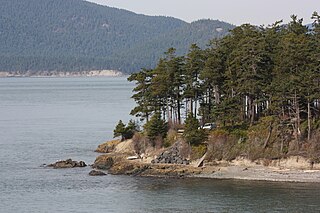
The Douglas fir is an evergreen conifer species in the pine family, Pinaceae. It is native to western North America and is also known as Douglas-fir, Douglas spruce, Oregon pine, and Columbian pine. There are three varieties: coast Douglas-fir, Rocky Mountain Douglas-fir and Mexican Douglas-fir.

Pinus radiata, the Monterey pine, insignis pine or radiata pine, is a species of pine native to the Central Coast of California and Mexico. It is an evergreen conifer in the family Pinaceae.

The Torrey pine is a rare pine species in California, United States. It is a critically endangered species growing only in coastal San Diego County, and on Santa Rosa Island, offshore from Santa Barbara in Santa Barbara County. The Torrey pine is endemic to the California coastal sage and chaparral ecoregion.

Pinus strobus, commonly called the eastern white pine, northern white pine, white pine, Weymouth pine (British), and soft pine is a large pine native to eastern North America. It occurs from Newfoundland, Canada west through the Great Lakes region to southeastern Manitoba and Minnesota, United States, and south along the Appalachian Mountains and upper Piedmont to northernmost Georgia and perhaps very rarely in some of the higher elevations in northeastern Alabama. It is considered rare in Indiana.

Fokienia is a genus of conifer tree belonging to the cypress family. In its characteristics, Fokienia is intermediate between the genera of Chamaecyparis and Calocedrus. Genetically Fokienia is much closer to Chamaecyparis, and not all researchers recognize Fokienia as a separate genus. The genus comprises only one living species, Fokienia hodginsii or Fujian cypress, and one fossil species.

Cupressus bakeri, reclassified as Hesperocyparis bakeri, with the common names Baker cypress, Modoc cypress, or Siskiyou cypress, is a rare species of cypress tree endemic to a small area across far northern California and extreme southwestern Oregon, in the western United States.
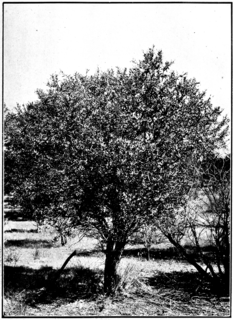
Santalum spicatum, the Australian sandalwood, also Waang and other names (Noongar) and Dutjahn (Martu), is a tree native to semi-arid areas at the edge of Southwest Australia, in the state of Western Australia. It is also found in South Australia, where it is protected and listed as a vulnerable species. It is traded as sandalwood, and its sandalwood oil has been used as an aromatic and a food source over history. S. spicatum is one of four Santalum species occurring in Australia.
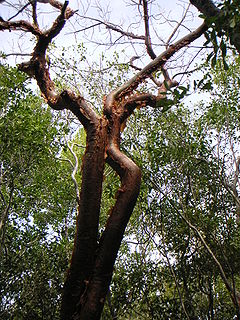
Bursera simaruba, commonly known as gumbo-limbo, copperwood, chaca, West Indian birch, naked Indian, and turpentine tree, is a tree species in the family Burseraceae, native to the Neotropics, from South Florida to Mexico and the Caribbean to Brazil, Nicaragua, and Venezuela. Bursera simaruba is prevalent in the Petenes mangroves ecoregion of the Yucatán, where it is a subdominant plant species to mangroves. Specimens may be found along the western coast of Florida.

The Dryandra Woodland is a national park in Western Australia within the Shires of Cuballing, Williams and Wandering, about 164 kilometres south-east of Perth and 22 kilometres north-west of the town of Narrogin. It is a complex of 17 distinct blocks managed by the Western Australian Department of Parks and Wildlife and spread over approximately 50 kilometres separated by areas of agricultural land. The area is considered to be one of the state's major conservation areas, and although it is far from pristine due to its history of logging operations, a number of species of threatened fauna are rebuilding populations through the removal of introduced predators such as foxes and feral cats.

Calocedrus macrolepis is a conifer native to southwest China, northern Vietnam, northern Laos, extreme northern Thailand and northeastern Myanmar.

Santalum album, or Indian sandalwood, is a small tropical tree, and the traditional source of sandalwood oil. It is native to southern India and Southeast Asia. It is considered sacred in some religions like Hinduism, and some cultures place great significance on its fragrant qualities. However, the high value of the species has caused over-exploitation, to the point where the wild population is vulnerable to extinction. Indian sandalwood still commands high prices for its essential oil owing to its high alpha santalol content, but due to lack of sizable trees it is no longer used for fine woodworking as before. The plant is long-lived, but harvest is only viable after many years.
Dalbergia oliveri is a species of legume in the family Fabaceae which grows in tree form to 15 – 30 meters in height. The fruit is a green pod containing one to two seeds which turn brown to black when ripe. It is threatened by habitat loss and over-harvesting for its valuable red "rosewood" timber.
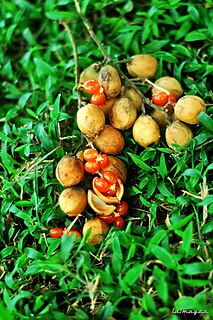
Baccaurea polyneura is a species of plant in the family Phyllanthaceae. It is native to Peninsular Malaysia, and Sumatra island of Indonesia. The fruit, called jentik, is edible, if sour, and is locally harvested and sold.
Machilus nanmu is a species of evergreen tree in the family Lauraceae. It is endemic to Sichuan and northeastern Yunnan provinces in southern China. M. nanmu is threatened by habitat loss due primarily to overcutting.
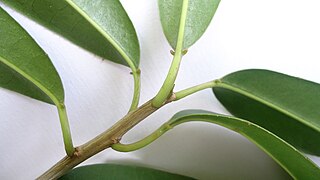
Sapium glandulosum is a species of tree in the family Euphorbiaceae. It is native to the Neotropics from Mexico and the Caribbean south to Argentina, and it has been cultivated elsewhere. It is the most common Sapium species. Its common names include gumtree, milktree, leche de olivo, and olivo macho.

Dalbergia latifolia is a premier timber species, also known as the Indian rosewood. It is native to low-elevation tropical monsoon forests of south east India. Some common names in English include rosewood, Bombay blackwood, roseta rosewood, East Indian rosewood, reddish-brown rosewood, Indian palisandre, and Java palisandre. Its Indian common names are beete, and satisal. The tree grows to 40 metres (130 ft) in height and is evergreen, but locally deciduous in drier subpopulations.

Syzygium nervosum is a species of tree native to tropical Asia and Australia, extending as far north as Guangdong and Guangxi in China and as far south as the Northern Territory of Australia. It was previously known as Cleistocalyx operculatus and also known as C. nervosum(DC.) Kosterm., and Eugenia operculataRoxb., 1832. It is a medium-sized tree of about 10 meters in height with pale brown bark and dull green leaves.
Nothaphoebe umbelliflora is an evergreen tropical tree in the family Lauraceae. Its common name in English is the bong tree. It is also called the yang bong tree (Thai), or gemor.
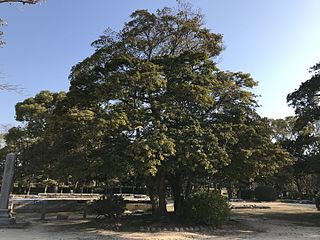
Machilus thunbergii, the Japanese bay tree, red machilus, or tabunoki, is a widespread species of flowering plant in the family Lauraceae. It is native to Vietnam, Taiwan, southeast and north-central China, the Korean Peninsula, and Japan. A sturdy evergreen tree, usually 10–15 m (30–50 ft) tall, and reaching 20 m (70 ft), it is used for timber, and as a street tree. Its bark is the source of makko, a powder used to make a mosquito‑repelling incense. It prefers coastal areas, and can handle saline soil.

Cassipourea malosana is a species of plant native to tropical Africa.

















